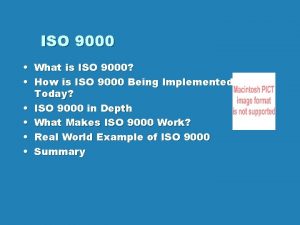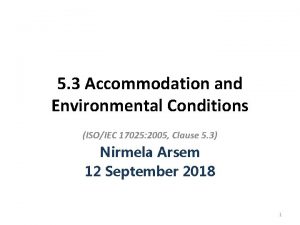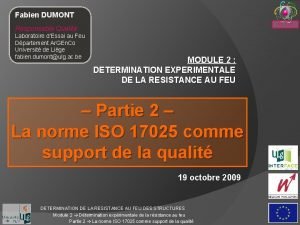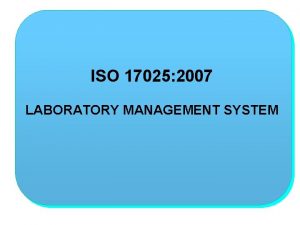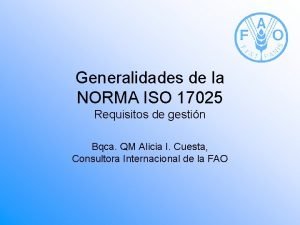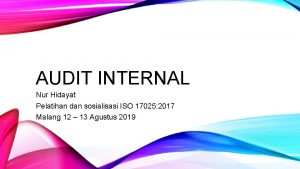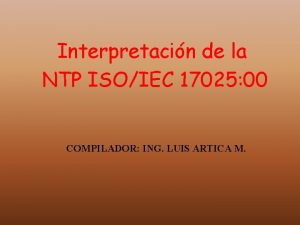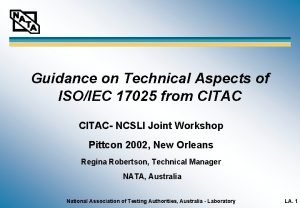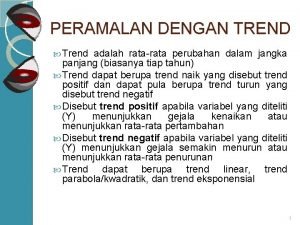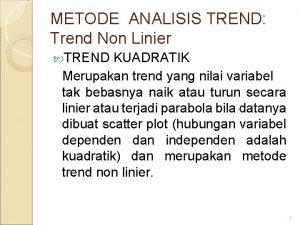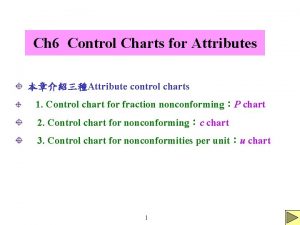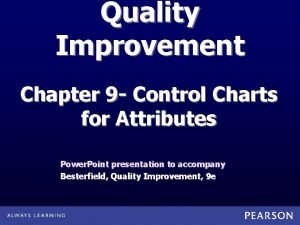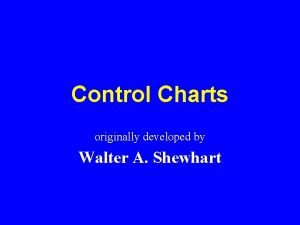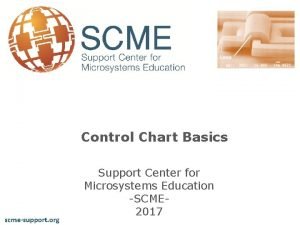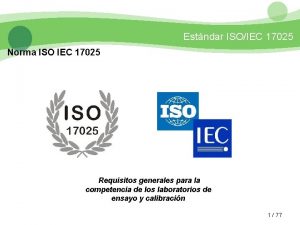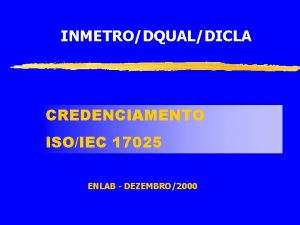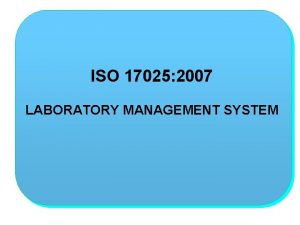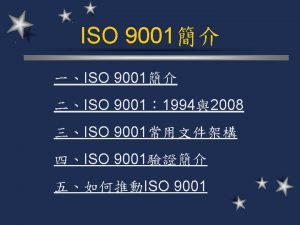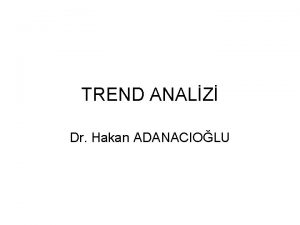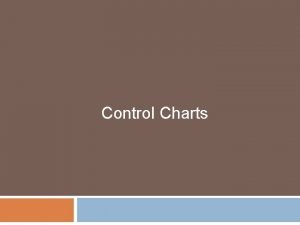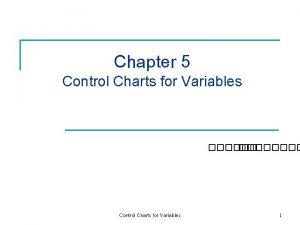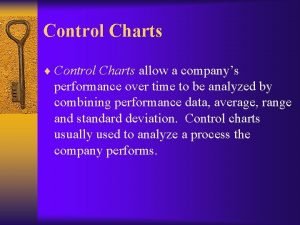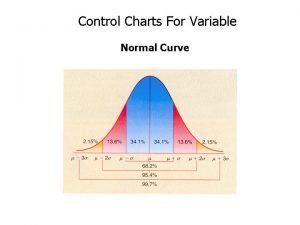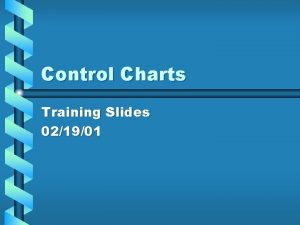Control Charts and Trend Analysis for ISO 17025















- Slides: 15

Control Charts and Trend Analysis for ISO 17025 Speakers: Karen Stephani Kristen Durie

Food Lab Metrics: At the New York State Food lab we have: o o # of Microbiological Trend Charts # of Microbiological Control Charts # of PDP Control Charts # of Chemistry Control Charts

NYS Food Lab Requirements GP-5 -15 Section 5. 2 Control Charting: GP-5 -15 Trending Analysis, Control Charting, and Calculation of Measurement Uncertainty, Section 5. 2: A control chart is a graph of test results with respect to time or sequence of measurements, with limits drawn within which results are expected to lie when the analysis is in a state of “statistical control”. A procedure is in statistical control when results consistently fall within established control limits. Control charts can be constructed by hand or by using a commercial QC or statistical software (e. g. NWA Quality Analyst), or a spreadsheet (e. g. Excel). Each section of the laboratory shall determine the appropriate control charts to use for their specific analytical methods. Examples of control charts are the Mean Value control chart and the Range control chart.

Mean Value Control Charts: 3 types of Mean Value Control Charts we discuss in our SOP: Lab Control Sample charts (QC samples) Matrix Spike Control samples Process control charts – this is just like the QC one, just spelled out in more detail in the SOP for our purposes.

Mean Value Control Charts: Control Charts for Laboratory Control Samples These are charts created using a “QC” sample – this can be a reference material, an old PT sample, etc, but it must have a known value associated with it. This may be characterized by your laboratory. We use Excel to create our control charts. We try to use a QC that is a similar matrix and close to the range of expected results. Each time the QC is run, the analyst enters the point into the control chart, and this allows them to quickly see if the run passed or failed.

Mean Value Control Charts: Control Chart for Matrix Spikes These are charts created using a blank matrix that has been spiked with a known concentration of analyte. Note that finding a blank matrix can often be problematic, especially if you are looking for trace level analytes. These are used when an appropriate reference material is unavailable. This is typical with food testing, as finding RMs in the right matrix is often difficult and/or cost prohibitive. We chart the percent recovery of the spike. As long as the results fall within specified criteria, the QC passes. A typical acceptance for matrix spikes is 70 – 120%, but for large screens with many analytes, often 50 – 150% is acceptable.

Mean Value Control Charts: Calculating control limits: If an RM is being used that has a certified value with statistics (i. e. an acceptable range or standard deviation), we will create a control chart using those numbers as our upper and lower control limits and upper and lower warning limits After 20 points have been added to the chart, we will then calculate our own in-house statistics to determine our UCL/LCL and UWL/LWL We also recalculate after 20 -40 points to update our inhouse statistics

Mean Value Control Charts: Control Limits for Mean Value Control Charts, GP-5 -15, section 5. 3. 4. 6: Since the control limits are based on probability, when a system is in statistical control o 2/3 of the values should be within the mean ± 1 s. o 19/20 or 95 % of the values should be within the mean ± 2 s. (Upper and Lower Warning Limits) o “All” or 99. 7% of the values should be within the mean ± 3 s. (Upper and Lower Control Limits)

NYS Food Lab Requirements Control Chart Interpretation: For Mean Value Control Charts, the process may be out of control if: One value or more fall outside 3 s (outside the upper or lower control limits). Two or more consecutive values fall outside 2 s (outside the upper or lower warning limits) on the same side of the mean. A series of seven or eight consecutive values fall above or all below the mean. An increasing or decreasing trend is detected.

Range Control Charts: Control Chart for Duplicate Sample Data: These are used when using the same QC sample over time to generate an average is impossible, and spiking is not an option. (Dairy chemistry samples, for example) Two samples in a batch are analyzed in duplicate and the % difference or the absolute difference of the duplicates is plotted. After 10 -20 points have been collected, calculate the average range of duplicates. There are tables (Youden) for determining the percentage that should fall above and below the “ 50% line” We are not currently using these in the lab for any accredited analyses, so we are NOT the experts – seek more guidance on Range control charts elsewhere!

Measurement Uncertainty: We also use our control charts to estimate our measurement uncertainty, as required by section 5. 4. 6 of the standard: Testing laboratories shall have and shall apply procedures for estimating the uncertainty of measurement. Section 5. 4. 6. 2 of our Quality Manual states: The NYS Food Laboratory maintains control charts as described in NYS SOP GP-5 -15: Trending Analysis, Control Charting and Calculation of Measurement Uncertainty. Control chart limits are used to estimate measurement uncertainty, unless otherwise specified in the method procedure.

Measurement Uncertainty: GP-5 -15 section 5. 6 details how we calculate our measurement uncertainty: When the laboratory control sample (LCS) can be run through all method steps, the standard deviation (SD) from the LCS precision data shall be used as an estimate of combined measurement uncertainty. A relative SD (or CV) may also be used. It is recommended that 20 or more data points be obtained to estimate the standard deviation and/or relative standard deviation. The estimate of uncertainty shall be calculated using the formula: Measurement Uncertainty for a Defined Matrix (LCS) = k x SD Where k (the coverage factor) equals 2 (for 95% confidence) when using 20 data points. If fewer than 20 LCS data points are available, the coverage factor k should be the appropriate t statistic for 95% confidence for the associated degrees of freedom. Consult an appropriate student’s t-distribution table.

Trend Analysis 5. 5. 5 – 5. 5. 9 of GP-5 -15 The objective of reviewing control charts is to catch problems and make corrections before the situation has become “out of control”. Systematic trends shall be investigated. Charts shall be monitored by analysts entering data, whenever practicable. All charts shall be reviewed on a routine basis by the Quality Assurance Officer (QAO) responsible for the specific section of the laboratory. The section QAO shall determine the time period (e. g. once a month) or a number of points collected (e. g. 10 data points) as a definition of “routine basis”. Documenting out of control situations shall be the responsibility of the analyst, the section supervisor and the QAO. If it is determined the process is out of control, a corrective action shall be started.

Qualitative Tests - Microbiology Requirement: “For qualitative tests appropriate controls shall be included whenever possible in order to demonstrate that the test worked. The suitability of the controls used shall be justified by the laboratory. ” Every SOP states what positive and negative controls shall be used in that procedure: MICRO-MTH-301 Salmonella VIDAS Method 6. 3. 1 A positive culture control (Salmonella (sp) Typhimurium, MDP-014, p. YA 3553) and negative culture control (E. coli ATCC 25922) shall be run with each day’s batch of samples.

Qualitative Tests - Microbiology Excel spread sheet VIDAS – tracking false positive rate using “Test Value” PCR ABI 7500 fast – tracking false positive rate using number of cycles.
 Iso 9000 iso 9001 iso 9002 iso 9003 iso 9004
Iso 9000 iso 9001 iso 9002 iso 9003 iso 9004 Iso 17025 facilities and environmental conditions
Iso 17025 facilities and environmental conditions Iso dumont
Iso dumont Iso 17025 laboratory management system
Iso 17025 laboratory management system Requisitos iso 17025
Requisitos iso 17025 Daftar pertanyaan audit internal iso 17025:2017
Daftar pertanyaan audit internal iso 17025:2017 Ntp iso 17025
Ntp iso 17025 Ntp 17025
Ntp 17025 Ntp 17025
Ntp 17025 Miller street near me
Miller street near me Contoh soal metode trend kuadratik
Contoh soal metode trend kuadratik Metode kuadratik
Metode kuadratik 3 sigma limits
3 sigma limits Attribute control charts
Attribute control charts Walter shewhart control chart
Walter shewhart control chart Weco rules for control charts
Weco rules for control charts
